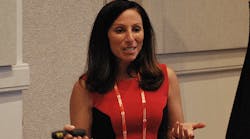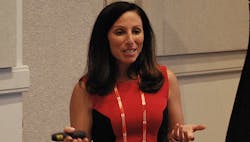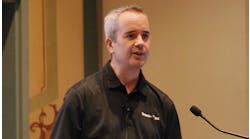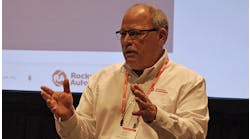“Culture starts with everyone that works in the organization, including your management.” Rockwell’s Albina Ortiz explained how to empower and develop a vibrant workforce in these challenging times.
The two reasons people leave their jobs are opportunity for growth and lack of training, said Albina Ortiz, global operations manager for customer training at Rockwell Automation. At ROKLive she gave a presentation on “Leading Practices for Empowering Your Workforce During the Great Resignation.” She discussed many strategies to overcome the workforce shortages that many are facing. The most important strategies include empowering the current workforce, training employees to retain them and building a company culture that values employees and supports workforce development.
Ortiz said the skills gap is only getting wider. According to analysis from Deloitte, based on data from the U.S. Bureau of Labor Statistics and Gallup, 2.7 million Baby Boomers will retire by 2025. The current expectation is that 3.4 million manufacturing jobs will be needed, and 2 million of those jobs will go unfilled.
“When we’re talking about empowering our workforce, what we’re talking about is giving our employees the autonomy, the tools, the training and the technology, as well as the responsibility to be able to do their jobs,” said Ortiz.
Building a robust and high-performing workforce means spending less time reacting and more time planning, she explained. This includes planning individually with employees to carve their career paths in the company, but also planning as an organization. Do you know where you’re going? Are your employees coming with you?
“Things change on the fly, and we have to be agile enough to be able to change on the fly,” Ortiz said.
It’s important to train employees in order to retain them. “For them to be self-sufficient, we have to be able to provide them with the training,” Ortiz said. Not all employees learn the same, and it’s important to use different types of training to match people’s needs, such as e-learning formats, instructor-led training or coaching on the job. “There are so many different things that you can do to make sure that you’re providing employees the training that they need, so that they can be successful in the business,” Ortiz said. “Make sure you’re adjusting that training and tailoring it to each individual.” Every employee or those in similar positions should not all have the same training path.
Ortiz said investing in your employees isn’t only about a structured program. “Get that knowledge from those people that are retiring and do some type of coaching; invest that time so that they can learn from one another,” Ortiz said.
She also outlined three strategies for an agile and flexible workforce. To attract new workers to manufacturing and to a company specifically, “we need to find ways to make ourselves attractive to them,” Ortiz said. Companies need to work collaboratively with employees on programs that build their skills.
“That is your brand; this is what’s going to bring employees in,” Ortiz said.
Culture is also an important part of employee retention. “Culture starts with everyone that works in the organization, including your management,” Ortiz said. Managers need to be spending one-on-one time with their employees to understand their career ambitions and needs. Talk with employees about where the company is and where their career path is going. That may mean modifying a position to fit the needs and skills of employees you want to retain.
“Make sure you set that brand, that image, that you want with that focus on your employees,” Ortiz said. “I don’t mean just create an image. You have to live, breathe and believe that image.”
Ortiz encourages companies to embrace tactics that support workforce flexibility, such as partnerships, technology and investing in people.
“If you’re going to give people the autonomy to make decisions on their own, you need to be supportive of that, too,” Ortiz said. Employers need to understand what’s important to employees. For many, that is workforce flexibility.
“It shouldn’t be, this is how it is: black and white,” Ortiz said. “Can you make it more flexible?” Companies retain employees through engagement, training and knowledge transfer. “Make sure that your employees feel valued and important,” Ortiz said.
The initial onboarding process can be an important time to establish company culture and show employees they are valued. Do employees have everything they need at the start? Do managers meet with new employees right away, or do they just meet with HR?
LinkedIn can be an effective means to not only attract new employees, but also help focus on company culture. Globally, LinkedIn has 800 million members in more than 200 countries. “Social media is a great way to be able to bring employees in and at least get your company name out there,” Ortiz said. Work the algorithm, she recommends. The LinkedIn algorithm ultimately determines what content is prioritized in your LinkedIn feed, as well as the reach your content receives in others’ feeds. She recommends posting or sharing two to five times a week. And do more than share, also like comments and add your own. Ortiz said the algorithm values comments the most.
How long does it take to get a new employee up to speed? It depends on the role, Ortiz said, but on average it takes 90 days for employees to start their career journeys and up to one year for them to be fully effective in their new roles. “Do we really have that kind of time, instead of just investing in training the people we have,” Ortiz asked.
The editors of Control, Control Design and Smart Industry are reporting live from ROKLive 2022 in Orlando, Florida, to bring you the latest news and insights from the event. When the event comes to a close, the best, most important coverage will be compiled into a report by the editors.
Register now to pre-order the report and be among the first to receive it in your inbox.





